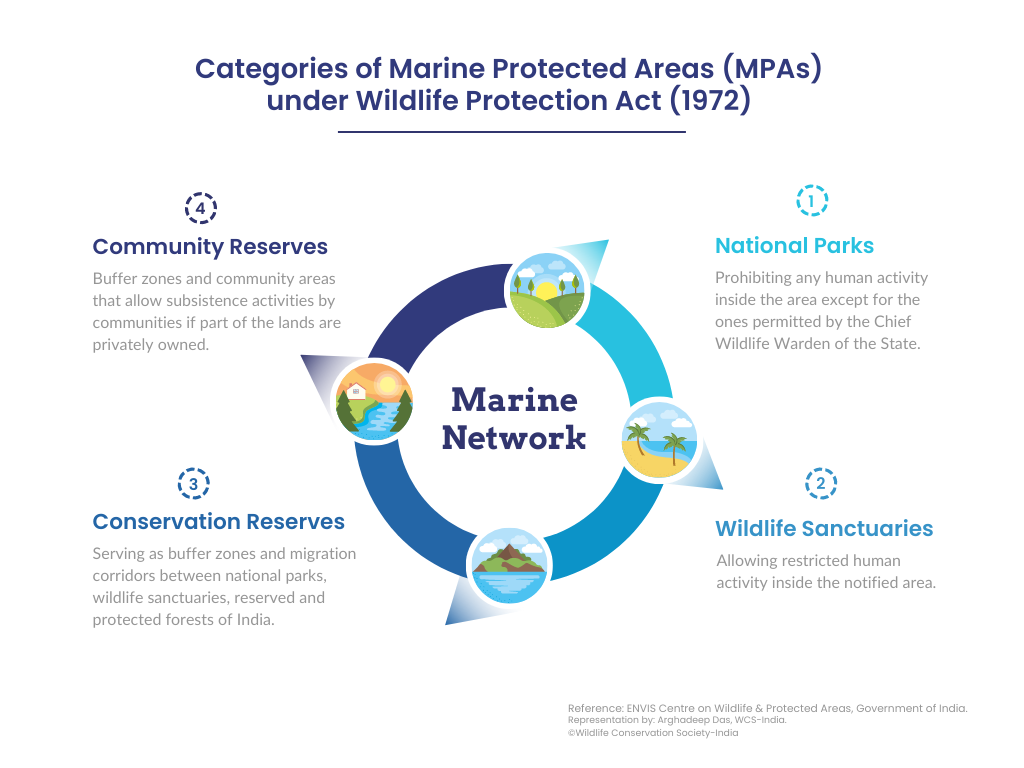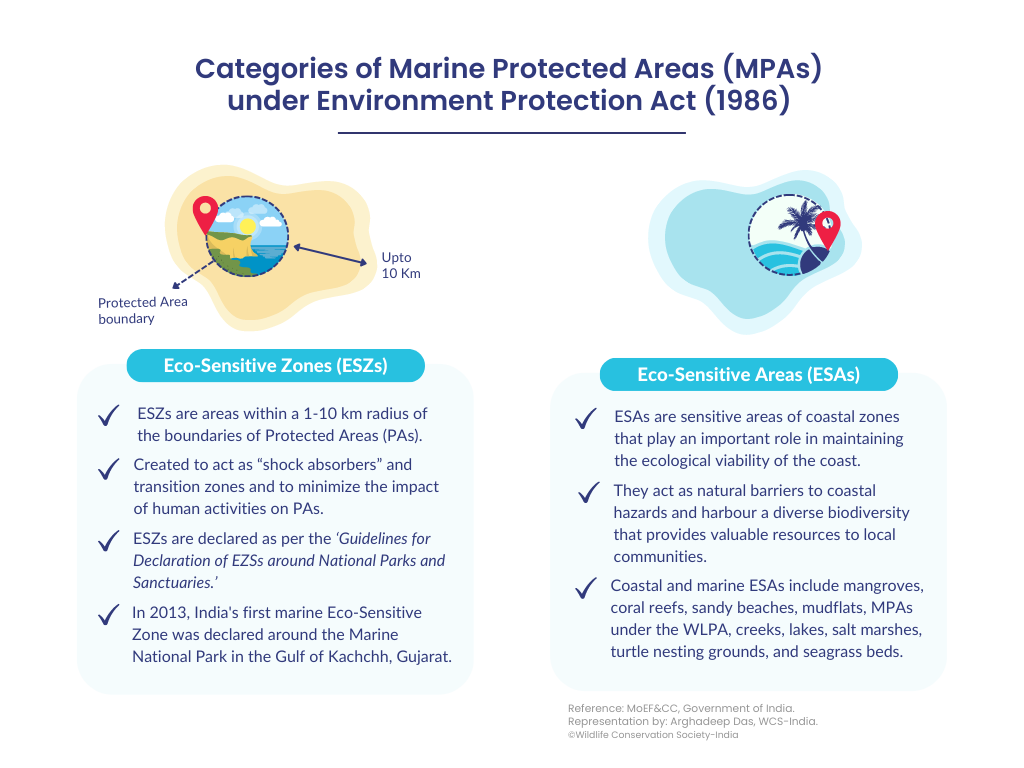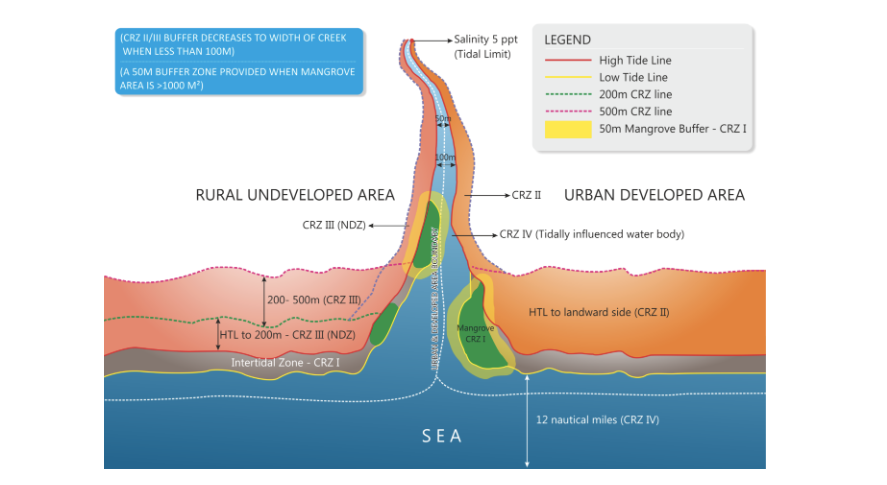The WLPA is the primary law used for the creation of MPAs in India. It provides for the declaration of four kinds of protected areas - national parks, sanctuaries, conservation reserves, and community reserves.[1]. These categories are meant to promote in situ conservation of species by preventing human incursion in their habitats[2]. The WLPA is said to be a terrestrially oriented law that is applied to protect coastal and marine areas[3]. and there are no separate provisions laid out in the Act to declare MPAs.

[1] notified under sections 18, 35, 36A and 36C of the WPA
[2] Sections 18 (declaration of a sanctuary); Section 27 to 33 (restrictions in PAs); Section 35 (declaration of national parks); Section 36A to 36D (declaration and management of conservation and community reserves)
[3] https://science.thewire.in/law/wildlife-protection-act-1972-unsuitable-india-marine-ecosystems/
The MZA was enacted to provide for matters relating to India’s maritime zones up to 200 nautical miles). As per the Territorial Waters, Continental Shelf, Exclusive Economic Zone and Other Maritime Zones Act, 1976 (MZA), India has four main maritime zones:
| Territorial Waters | Contiguous Zone | Continental Shelf | EEZ |
|---|---|---|---|
| Extends up to 12 nautical miles from the coastal baseline | Extends up to 24 nautical miles from the coastal baseline | Comprises of seabed and subsoil and extends to 200 nautical miles from the coastal baseline | Extends to 200 nautical miles from the coastal baseline |
At present, most MPAs established under the WLPA are only within the territorial waters of India since the provisions of the WLPA are not applicable to the EEZ. MZA, on the other hand, offers scope for implementation of MPAs in maritime zones beyond the territorial waters.
Under the MZA, the Ministry of External Affairs (MoEA), can declare certain areas in the Continental Shelf and in the EEZ as ‘designated areas’ and make provisions for “the protection of marine environment” and “the exploration, exploitation and protection of the resources of in such designated areas.
[4] Notification S.O. 429(E) dated the 18.07.1986
The Environment Protection Act (EPA) builds on India’s participation at the Stockholm Conference, 1972 and aims to protect and improve the environment. The Act authorizes the central government to protect and improve the quality of the environment, prevent and abate environmental pollution in all its forms, and restrict industrial activities or processes that exceed the emission standards to prevent environmental hazards or accidents.
| Eco-Sensitive Zones (ESZs) | Eco-Sensitive Areas (ESAs) |
|---|---|
| ESZs are areas within a 1 - 10km radius of the boundaries of PAs that are created to act as “shock absorbers” and transition zones, and to minimize the impact of human activities on PAs. ESZs are declared as per the ‘Guidelines for Declaration of EZSs around National Parks and Sanctuaries.’ In 2013, the MoEF&CC declared India's first marine Eco-Sensitive Zone around the Marine National Park in the Gulf of Kachchh, Gujarat[5].. |
ESAs in the coasts have been defined as “the areas of coastal zones that play an important role in maintaining the functional integrity of the coast, including acting as natural barriers to coastal hazards and, or harbouring a diverse biodiversity that provides valuable resources to local communities.” [6]. ESAs are declared under the EPA. Coastal and marine areas include mangroves, coral reefs, sandy beaches, sand dunes, mudflats, MPAs under the WLPA, creeks and lakes, salt marshes, turtle nesting grounds, seagrass beds. |

| ESZ Activities | ESA Activities |
|---|---|
| Activities within ESZs are categorised into prohibited, regulated and permitted: Prohibited: Commercial mining, saw mills, hydroelectric projects, discharge of effluents and solid wastes, production of hazardous substances Regulated: Felling of trees, establishing hotels and resorts, widening of roads, erection of cables, commercial use of water resources Permitted: Agriculture and horticulture practices by local communities, rain water harvesting, organic farming, use of renewable resources |
The Central Government can prohibit or restrict the location of industries and carry on certain operations or processes on the basis of considerations like the biological diversity of an area, maximum allowable limits of concentration of pollutants for an area, environmentally compatible land use and proximity to protected areas. The Central Government can impose specific restrictions while declaring an area as an ESA and issuing a notification for the same. |
Under the EPA, the Central Pollution Control Board (CPCB), State Pollution Control Board (SPCB), and District Level Committees (DLCs) are empowered to implement the law.
The notification was first issued in 1991 (CRZ 1991) under the EPA. This was an attempt to conserve and protect the coastal regions of India by permitting only those activities, the operation of which absolutely depended on being located in coastal regions. In the 30 years since, the notification has been modified 34 times.
In 2011, the MoEF&CC issued a CRZ notification (CRZ 2011) which consolidated the modifications to CRZ 1991 and made further amendments to it. The primary aim of CRZ 2011 was to conserve and protect coastal stretches while promoting sustainable development. In 2019, the MoEF&CC replaced CRZ 2011 with the CRZ notification of 2019 (CRZ 2019) with the aim of enhancing activities in the coastal regions to promote economic growth while protecting coastal regions.
| Sl.No. | Category | Description |
|---|---|---|
| 1 | CRZ-1 A | Ecologically Sensitive Areas (ESAs) like mangroves, coral reefs, protected areas, turtle nesting grounds etc. |
| 2 | CRZ-I B | Area between the Low Tide Line (LTL) and the High Tide Line. |
| 3 | CRZ-II | Developed land areas close to the shoreline, within existing municipal limits. |
| 4 | CRZ-III | Areas that are relatively undisturbed in rural areas, etc. and do not fall under CRZ-II. |
| 5 | CRZ-IV | Water area and the sea bed area from the LTL to the limit of territorial waters of India |
| 6 | Areas requiring special consideration in the CRZ | |
| 6.1. | Critically Vulnerable Coastal Areas (CVCA) | Managed with the involvement of coastal communities dependent on coastal resources for livelihood. Examples include the Sundarban region of West Bengal and other ecologically sensitive areas identified under Environment (Protection) Act, 1986 such as Gulf of Khambhat and Gulf of Kutch in Gujarat. |
| 6.2. | CRZ for inland backwater islands and islands along the mainland coast | CRZ of 20 meters from the HTL on the landward side. |
| 6.3. | CRZ areas falling within municipal limits of Greater Mumbai | All open spaces, parks, gardens, playgrounds indicated in development plans within CRZ-II categorised as No Development Zone and a Floor Space Index up to 15% shall be allowed only for recreational or sports related activities and not for residential or commercial use. |
Image source: Coastal Zone Management Plan-2011, National Centre for Sustainable Coastal Management Website, Govt. of India, https://czmp.ncscm.res.in/.

Firstly, as a general rule, it prohibits certain activities throughout CRZs. These activities include:
Secondly, it: (a) makes exceptions to the general rule; and (b) regulates certain activities. These regulations and exceptions differ over categories of CRZs i.e. CRZ-I, II, III and IV, progressing from most critical or sensitive areas to least critical or sensitive areas. Three categories of CRZ – CRZ I, II and III are landward side zones and CRZ IV is a waterside zone.
| CRZ Category | Activities Allowed* |
|---|---|
| CRZ-I A | a) Eco-tourism b) construction for defence, strategic and public utilities |
| CRZ-I B | a) Projects for defence and security purposes b) Foreshore facilities like ports and harbours c) Exploration and extraction of oil and natural gas d) Treatment facilities for waste and effluents |
| CRZ-II | a) All activities allowed in CRZ-I B b) Construction of public utilities such as residential buildings, schools and hospitals c) Tourism development projects |
| CRZ-III | a) Agriculture, horticulture, forestry b) Construction of public utilities like schools, bridges, roads etc c) Facilities required for local fishing communities such as fish drying yards and auction halls d) Temporary tourism facilities such as toilets, change rooms and drinking water facilities e) Mining of certain atomic minerals notified under Mining and Minerals (Development and Regulation) Act, 1957 |
| CRZ-IV | a) Traditional fishing and allied activities undertaken by local communities b) activities directly needing foreshore facilities c) facilities for discharging treated effluents, d) defence related projects |
*This is not an exhaustive list of activities permitted. To see the full extent of activities allowed, please refer to Section 5 of the CRZ Notification 2019.
The Biodiversity Act was introduced to check misappropriation of Indian biological resources and provides access to Indian biological resources and associated knowledge subject to certain restrictions. It also has a provision to declare Biodiversity Heritage Sites (BHS) which are areas with rich and fragile biodiversity. Currently, BHSs do not fall under the existing Protected Area network. Of the 18 BHSs declared in India, one established in Asramam, Kerala in 2019 consists of marine ecosystems - it hosts Mangrove species and a wide variety of fish.[7].
Biodiversity Heritage Sites (BHSs) are “well defined areas that are unique, ecologically fragile ecosystems - terrestrial, coastal and inland waters and, marine having rich biodiversity”[8]. BHSs can be declared by the State Government in consultation with the State Biodiversity Board and local bodies (gram sabhas, panchayats, forest protection committees, tribal councils etc)[9]. and are managed and conserved as per state rules.
The NBA and SBBSs are mandated to (a) regulate the use of India's biological resources; (b) advise the Central and State Governments on matters relating to conservation of biodiversity, sustainable use of resources and equitable benefit sharing of biological resources; and (c) in selection and management of areas to be designated as BHSs.[10].
[7] http://www.wiienvis.nic.in/Database/bhs_8650.aspx
[8] Guidelines for selection and management of the Biodiversity Heritage Sites
http://nbaindia.org/uploaded/ut/Final%20BHS%20guidelines%20approved%20in%20the%2019th%20Authority.pdf
[9] Section 37
The Scheduled Tribes and Other Traditional Forest Dwellers (Recognition Of Forest Rights) Act, 2006 also known as Forest Rights Act (FRA) recognises, restores and vests the rights of the Forest Dwelling Schedule Tribes (FDST) and the Other Traditional Forest Dwellers (OTFD) that have lived in the forest for generations. It recognises the relationship of forest dwellers with the forest and their role in achieving sustainable use, biodiversity conservation and maintenance of ecological balance. This law may be applicable in forest lands within coastal areas wherein forest dwellers have traditional usage rights.
FRA identifies four types of rights:
1) Title rights: These are ownership rights given to forest dwellers.
2) Use rights: These are rights given to forest dwellers to extract minor forest produce or other resources.
3) Relief and development rights: These are rights to basic amenities given to rehabilitate dwellers in case they have been illegally evicted or displaced.
4) Forest management rights: These are rights of the dweller to protect, regenerate or conserve or manage forest as they have traditionally done.
The forest land covered by FRA are those that forest dwellers have rights over as “individual rights” or as “community rights”. Following are specific areas covered under the act :
| 1) Community forest resource | Customary forest land located within a villages’ boundaries, lands used seasonally by tribal people and other reserved and protected forests and areas. |
| 2) Critically wildlife habitat | Areas notified by Central government if they meet a scientific and objective criteria, under which these areas must remain inviolate for reasons of wildlife conservation. |
Central government, mainly through the Ministry of Tribal Affairs, has the power to make rules under the act to carry out its objectives.
[10] Sections 18, 19, 20 and 21 of the Biodiversity Act
The act passed in 1927, consolidates laws relating to forests, forest produce, their transit and duty leviable over timber and other forest produce. This law is applicable to forest lands found within coastal areas especially mangrove forests which are usually declared as reserve forests.
The areas covered under the act are:
1) Reserved Forests
2) Village Forests
3) Protected Forests